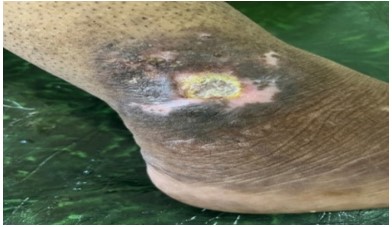Management of Dushtavrana (Non-Healing Ulcer) through Ayurveda - A Case Report
DOI:
https://doi.org/10.21760/jaims.9.3.34Keywords:
Yavadi Kalka, Jaloukavacharana, Dushtavrana, Non healing ulcerAbstract
Shalyatantra is one among the Astang Ayurveda, the branch of Shalyatantra refers to surgical and parasurgical procedures in Ayurveda. Dusthavrana (non healing ulcer) are a frequently encountered problem in present era produced commonly as a complication of trauma or pathologic insult and it causes long term agony to the patient. The issue of non-healing ulcers management with Ayurvedic remedy is one of the major areas of the research and has come under increased study. This is a case report of 40-year-old female, who had an episode of Dushtavrana (non healing ulcer) and presented to the outpatient department with complaints of severe pain, itching and ulcer over right ankle region. The first line of management for Dushtavrana is Shodhana. Kalka is the specific treatment for Dusthavrana which is mentioned under Shodhana and Ropana Kriya of Saptopakrama. Yavadi Kalka is one of the formulations mentioned in Dwivraniya Chikitsa Adhyaya. Yavadi Kalka is simple, very cost-effective procedure. In the present case, Yavadi Kalka after Jaloukavacharana has shown assuring results in the management of Dushtavrana.
Downloads
References
Sri Ram Bhat M, SRB’s Manual of surgery, 7th edition, reprint on 2012, chapter 1st P 1-7.
Acharya Sushruta, Sushruta Samhita, translator by prof.k.r.sreekanthamurthy, published by chaukambha orientalia, reprint edition, 2010; chikitsa sthana 1st chapter, 3rd shloka P-3.
S Das, A concise textbook of surgery, 7th edition, reprint on, 2012; chapter 1st, P 7-8.
Acharya Sushruta, Sushruta Samhita, translator by prof.k.r.sreekanthamurthy, published by chaukambha orientalia, reprint edition, 2010; chikitsa sthana 1st chapter, 7,8 & 17th shloka P-3.
Acharya Sharangadhara, Sharangadhara Samhita of Pandit, edited by Pandit Parashurama Shashtri Vidyasagar, with Dipika commentary of Adhamalla and the Gudartha Dipika of Shri Kashirama:Chaukhambha Orientalia Varanasi; reprint 2013.Madhyama khanda Kalka Kalpana 5/2, P 397, P 174.
Sri Ram Bhat M, SRB’s Manual of surgery, 7th edition, reprint on 2012, chapter 13, P 674.
Naveen Kumar Chundran, Ike Rostikawati Husen, Irra Rubianti. Effect of Neem Leaves Extract (Azadirachta Indica) on Wound Healing. Althea Medical Journal. 2015;2(2)199-203.
http://www.ayurline.in sited on 27/6/2023
Vrushali Dipak Ghule et al: Conceptual Study Of Arogyavardhini Vati. International Ayurvedic Medical Journal {online} 2021 {cited December 2021} Available from: http://www.iamj.in/posts/images/upload/3098_3101.pdf
Sruthi CV, Sindhu A. A comparison of the antioxidant property of five Ayurvedic formulatins commonly used in the management of Vatavyadhis. J Ayurveda Integr Med 2012:3:29-32. Downloaded on 18/10/2023.
Lariya Neelam, Bhadrawat Anand, Role of Dhatrilauha in management of Garbhini pandu roga (Iron deficiency Anaemia in pregnant women),2023,9(8), 224-227. Downloaded on 18/10/2023.















